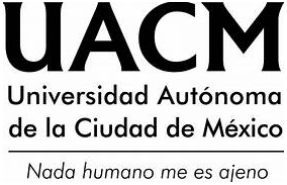Table dance industry from NAFTA in Mexico. Performance, body and little institutionalism
DOI:
https://doi.org/10.29092/uacm.v12i27.85Keywords:
Table dance, erotic dancers, performativity, striptease, institutional deficit, womenAbstract
This document is derived from a qualitative research conducted in Mexico and the United States. It is proposed to denature the table dance erotic industry in Mexico and is considered the context of free trade and the expectations it detonated. From the context, the performative and institutional analyzes the conceptual content of the body and pornotopia. It also offers poliperformatividad category as an aggregate of performative acts in order to understand the semiotics of the table dance. The problem of social stigma and silence are discussed and advirte of the difficulty of building citizenship on the part of this group of sex workers.
Downloads
References
Ayala Espino, J. (1999), Instituciones y economía. México: Fondo de Cultura Económica.
____(2003), Instituciones para mejorar el desarrollo. México: Fondo de Cultura Económica.
Barrero Díaz, G.P. (2004), “Bailarinas exóticas, striptease e inmigración en Canadá”, Revista Colombiana Internacional, Universidad de los Andes, núm. 59, enero-junio, pp. 142-158.
Bolívar Moreno, G. (2005), Sin tetas no hay paraíso. Bogotá: Quintero Editores.
Blauche, E. (2006), “Why I go to the Strip Clubs”, en D.R. Egan, K. Frank y M.L. Johnson (eds.), Flesh for Fantasy. New York, Thunder´s Mouth Press, pp. 97-99.
Bremer, S. (2006), “The gring”, en D.R. Egan, K. Frank y M.L. Johnson (eds.), Flesh for Fantasy. New York: Thunder´s Mouth Press, pp. 35-52.
Danko, J.P. (1988), Live Nude Girls. New York: St. Martin´s Griffin.
Egan, R.D., K. Frank y M.L. Johnson (2006), “Introduction”, en D.R.
Egan, K. Frank y M.L. Johnson (eds.), Flesh for Fantasy. New York: Thunder´s Mouth Press.
Foucault, M. (1997) [1976], Historia de la sexualidad I. La voluntad de saber, traducción de Ulises Guiñazú, 24ª ed. México: Siglo XXI Editores.
Frank, K. (2002), G-Strings and Sympathy. Strip Club Regulars and Male Desire, London, Duke University Press.
____(2006), “Observing the Observers: Reflections of my Regulars”, en D.R. Egan, K. Frank y M.L. Johnson (eds.), Flesh for Fantasy. New York: Thunder´s Mouth Press, pp. 111-138.
Freud, S. (1986) [1930], “El malestar en la cultura”, en S. Freud et al., A medio siglo de “El malestar en la cultura”, ed. de N. Braunstein. México: Siglo XXI Editores, pp. 13-116.
Fukuyama, F. (2004), La construcción del Estado. Hacia un nuevo orden mundial en el siglo XXI, traducción de M. Alonso, México, Ediciones B/Grupo Z.
Giddens, A. (2000), La transformación de la intimidad. Madrid: Cátedra.
González Rodríguez, S. (1989), Los bajos fondos: el antro, la bohemia y el café. México: Cal y Arena.
Granados, G. (2008), Susana: Memorias del table dance. México Grijalbo.
Gubern, R. (2000), El eros electrónico, Madrid, Taurus.
Johnson, M.L. (2006), “Stripper Bashing: An Autovideography of Violence Against Strippers”, en D.R. Egan, K Frank y M.L.
Johnson (eds.), Flesh for Fantasy. New York: Thunder´s Mouth Press, pp. 159-188.
Lagarde, M. (2001), Los cautiverios de las mujeres: madresposas, monjas, putas, presas y locas. México: Universidad Nacional Autónoma de México.
Lipovetsky, G. (2004), El imperio de lo efímero: la moda y su destino en las sociedades modernas. Barcelona: Anagrama.
López, G. (2008), “Estigma negativo como obstáculo para la construcción ciudadana”, en Silvia Bolos (coord.), Mujeres y espacio público: construcción y ejercicio de la ciudadanía. México: Universidad Iberoamericana, pp. 247-288.
____(2002), Espectáculo sexual, mercado y políticas públicas. México: Instituto Nacional de las Mujeres.
Manaster, S. (2006), “The lap dancer and the business man”, en D.R. Egan, K. Frank y M.L. Johnson (eds.), Flesh for Fantasy, pp. 53-62. New York: Thunder´s Mouth Press.
Montesinos, R. (2002), Las rutas de la masculinidad. Barcelona: Gedisa.
Morris, Desmond (2000), Femenino y masculino. Madrid: Plaza & Janés.
____(2004), La mujer desnuda, Madrid, Planeta.
Olvera Maldonado, B.G. (2006), “Bailando noche tras noche alrededor de un tubo: algunas características de las condiciones de trabajo en los table dance de la Zona Metropolitana de Guadalajara”, Revista de Estudios de Género, La Ventana/Universidad de Guadalajara, núm. 24, diciembre, pp. 320-342.
Ortega Ortiz, R.Y. (2001), “Tipos de transición: un estudio comparativo de España y México”, en R.Y. Ortega Ortiz (ed.), Caminos a la democracia, México, El Colegio de México.
Prieto Stambaugh, A. (2009), “¡Lucha libre! Actuaciones de teatralidad y performance”, en D. Adame (ed.), Actualidad de las artes escénicas. Perspectiva latinoamericana. México: Universidad Veracruzana-Facultad de Teatro, pp. 116-143.
Roemer, A. (1998), Sexualidad, derecho y política pública, México, Miguel Ángel Porrúa.
Weldone, J. (2006), “Whipped Cream, Fire Eating, and the Other Delights of Feature Dancing”, en D.R. Egan, K. Frank y M.L. Johnson (eds.), Flesh for Fantasy. New York: Thunder´s Mouth Press, pp. 85-94.
Páginas en Internet
Encuesta de acceso abierto (2006) http://www.tabledance.com.mx/encuestas (consulta: enero de 2010).
Published
Issue
Section
License
This Journal is licensed under Creative Commons Mexico 2.5. It is allowed to reproduce and disseminate the contents of the Journal for educational or research purposes, not for profit, as long as they are not mutilated and cite the source (Andamios, Revista de Investigación Social) and the author.
The copyright of the articles published in Andamios, Revista de Investigación Social are transferred by the author(s) to Universidad Autónoma de la Ciudad de México when the originals have been accepted, so that they are published and distributed both in the printed and electronic versions of the Journal. However, as established by law, the author(s) retains their moral rights. The author(s) will receive a form of assignment of copyright that they must to sign when their original has been accepted. In the case of collective articles, the signature of one of the authors will suffice, provided that the latter has obtained the consent of the others.
Authors may use the material of their article in other works or books published by themselves, with the condition of quoting Andamios as the original source of the texts.
The articles contained in this publication are the responsibility of their authors and do not compromise the official position of Andamios, Revista de Investigación Social of the Universidad Autónoma de la Ciudad de México.


